... about the real aircraft

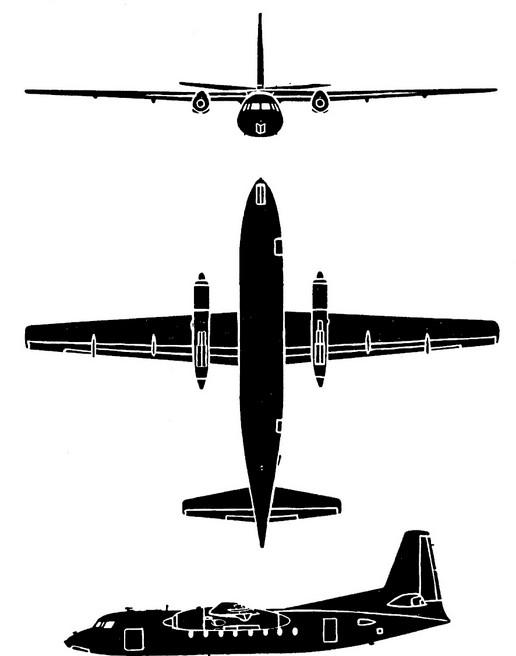

General History of the F.27
(by Meindert de Vreeze)
After the war, the Dutch Fokker Aircraft factory restarted production despite the fact that Anthony Fokker had passed away before World War II. The factories had suffered significant damage during the numerous bombings of the war. During the war, the German occupiers demanded the production of German planes and parts for the air war, but designing and building an aircraft was a different story.
The Dutch government saw potential in reviving the once-glorious Fokker aircraft company, which had been a major player in the aviation industry before the war. Despite the presence of thousands of surplus DC-3 planes, Fokker believed that there was a market for a fuel-efficient, modern propeller transport plane to replace the DC-3 Dakota. In 1950, the design team, led by Ir. H.C. van Meerten, began studying a high-wing aircraft with two turboprops. The advantage of this design was that it allowed for sufficient clearance and ground clearance for the large propellers to be used, and there would be less damage in the event of an emergency landing. All the fuel was stored in the wing, and there was a clear view from the cabin.
Various studies were conducted on Fokker “design 275” with different engines, such as the A.S. Mamba piston engine or the anticipated Rolls Royce Dart turbine engine, which was a revolution in itself due to its jet turbine drive. However, it promised to be a very reliable engine that would require less maintenance. In 1951, Fokker received a subsidy from the Dutch Institute for Aircraft Development (NIV), which was established to stimulate Dutch aircraft manufacturing aft the war. The Fokker company proceeded with wind tunnel tests at the Dutch National Aerospace Laboratory (NLL), later known as NLR.
The Royal Dutch Airlines KLM was also interested in carrying out its flight operations efficiently. The KLM founder Albert Plesman came up with the plan to rent and test the first F-27 aircraft with the necessary reservations. The Fokker company, of course, would rather preferred a simple order, no matter how small. However, with the NIV and KLM showing positive interest, the F-27 could count on some attention.
The Fokker company also had plans to unleash a new revolution in aircraft construction with the F-27, in addition to using a turboprop engine: the bonding of critical structures, known as Redux Bonding. This was a technique developed by Aero Research in England (Research Duxford=ReDux). This would result in lower weights than riveted light metal structures. Moreover, this would provide much better fatigue properties, although they were at the time not sure how it would turn out. Furthermore, glass fiber reinforced plastic was used in "non-primary critical parts," such as the cabin interior. They also chose to use pneumatic pressure to operate various systems such as the landing gear, brakes, and de-icing. Such a system was thought to be simpler and more reliable than oil hydraulics.
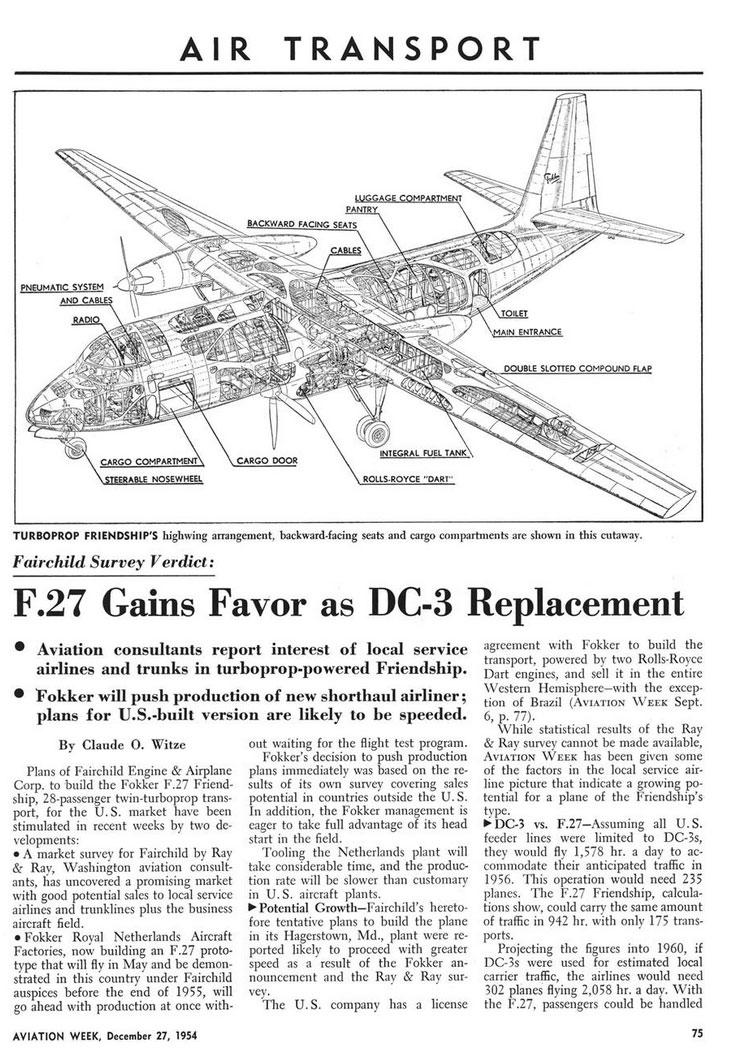
(old promotion article Aviation Week December 1954)
Fokker's studies resulted in the NIV granting permission in September 1953 to build a prototype and structural test objects. Fokker engineers went ahead with the production employees to built a prototype. The prototype of the F-27, the "F-1" with registration PH-NIV, made its first flight on November 24, 1955, piloted by Hugo Burgerhout. The aircraft was equipped with Dart 6 Mk-507 engines and 3.65 m diameter propellers. The flight behavior looked good except that the aircraft was a bit tail-heavy. It also had double slotted flaps, but they were not as effective as expected. Soon, they switched to simpler and lighter single slotted flaps for the other F-27s.
A subsequent prototype was built, which differed from the "F-1". Because the F-1 proved to be tail-heavy, the fuselage was lengthened by 90 cm in front of the wing between frame 6675 and frame 7125 (later named 6675A and frame 7125A) to improve the weight balance.
A third test aircraft, the "F-3 PH-NVF," made its first flight on January 29, 1957, and had Rolls Royce Dart 6 Mk-511 engines with slightly larger 3.60-meter propellers. The F-3 was also used for demonstration flights at various airlines and attracted considerable attention. It was even sold to LTU in 1963. (After many years, this aircraft has been restored and is now back with the Fokker Heritage Trust!).
The prototypes cost a total of around 25 million Dutch guilders, which were paid for by a loan from the government through the NIV. In the spring of 1956, production preparations for the F-27 began. During production, Fokker cooperated with other partners in Europe for the manufacture of various components, such as Breguet for the fuselage, Rolls Royce for the engines, and Dowty for the landing gear. The final assembly took place at the Fokker Schiphol plants. With the necessary urgency, development continued primarily for airlines, with Air Lingus from Ireland being the first customer. Various variations of the F-27 were also conceived for use not only as passenger planes, but also as cargo and military aircraft. The name Friendship was chosen for the civilian versions and Troopship for the military versions. Despite the ambitious plans, cost considerations led to some standardization. Certification also took some time because the American certification authority came with different regulations. Fokker naturally wanted a globally recognized certification, and on October 29, 1957, this was achieved.
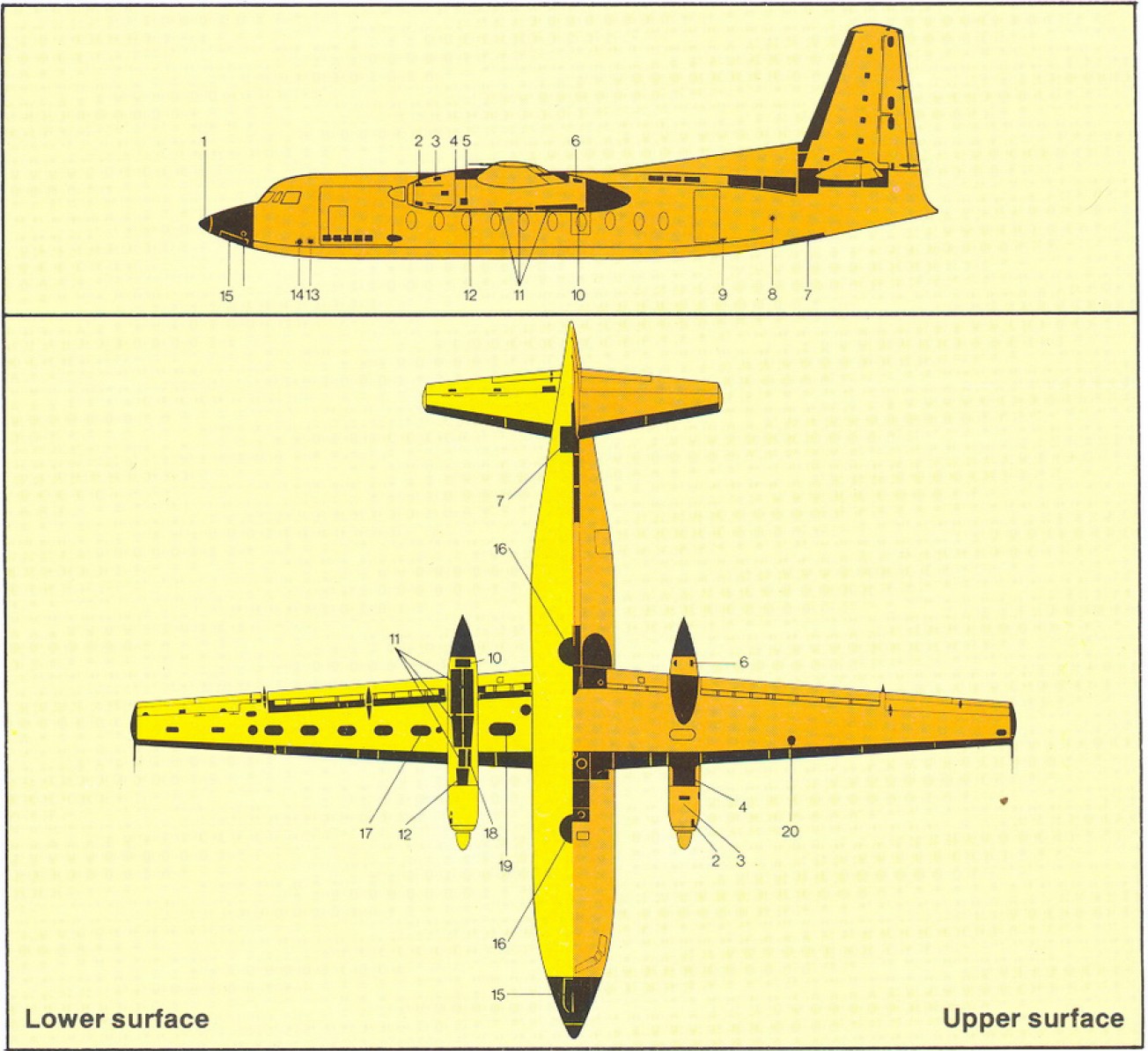
Airlines had already begun placing orders in 1956. The first customers included Trans Australian Airlines (6 planes), Braathens-SAFE (2), and Aer Lingus (6). Air Lingus also received the first production aircraft, the "F-5" with serial number 10105, which first flew in March 1958 and was delivered in December 1958. Soon after, the first commercial flights between Dublin and Paris were operated. The standard cabin of an F-27 was for 34 passengers, but many airlines installed 44 to even 48 seats in the a high density cabin layout.
Fairchild USA was also interested in building the F-27 under license, particularly for the American airline market. A contract was signed in 1956 with Fokker, and this F-27 version differed mainly in the systems. They also had a longer radar nose with weather radar (which was later also applied by Fokker). The first F-27 made by Fairchild, the "N1027," flew on April 12, 1958. Unfortunately, there was a problem with the pneumatic system, and the landing gear collapsed. The usable parts were removed, and a second prototype was built with the same registration number. The Fairchild F-27 was certified on July 16, 1958, by the American airworthiness authority CAA (later FAA). West Coast Airline received its first plane on July 24, 1958.
However, the Fokker company in the Netherlands started to worry as there were no follow-up orders for the F-27 Friendship. In 1958, Ansett Airlines from Australia had ordered six mk.200 aircraft, but there wasn't much else on the horizon. The Dutch government decided to order a number of planes for the Royal Netherlands Air Force. The order was for 9 Troopships (mk.300M) for primarily military cargo transport and troops, and 3 Friendships (mk.100) with passenger seats. The first mk.300M, the "C-4," for the KLu (Royal Netherlands Air Force) flew on August 17, 1960. By the way, the KLu was not the first customer for a military F-27; that distinction went to the Philippines, which received such an aircraft (c/n 10115) first.
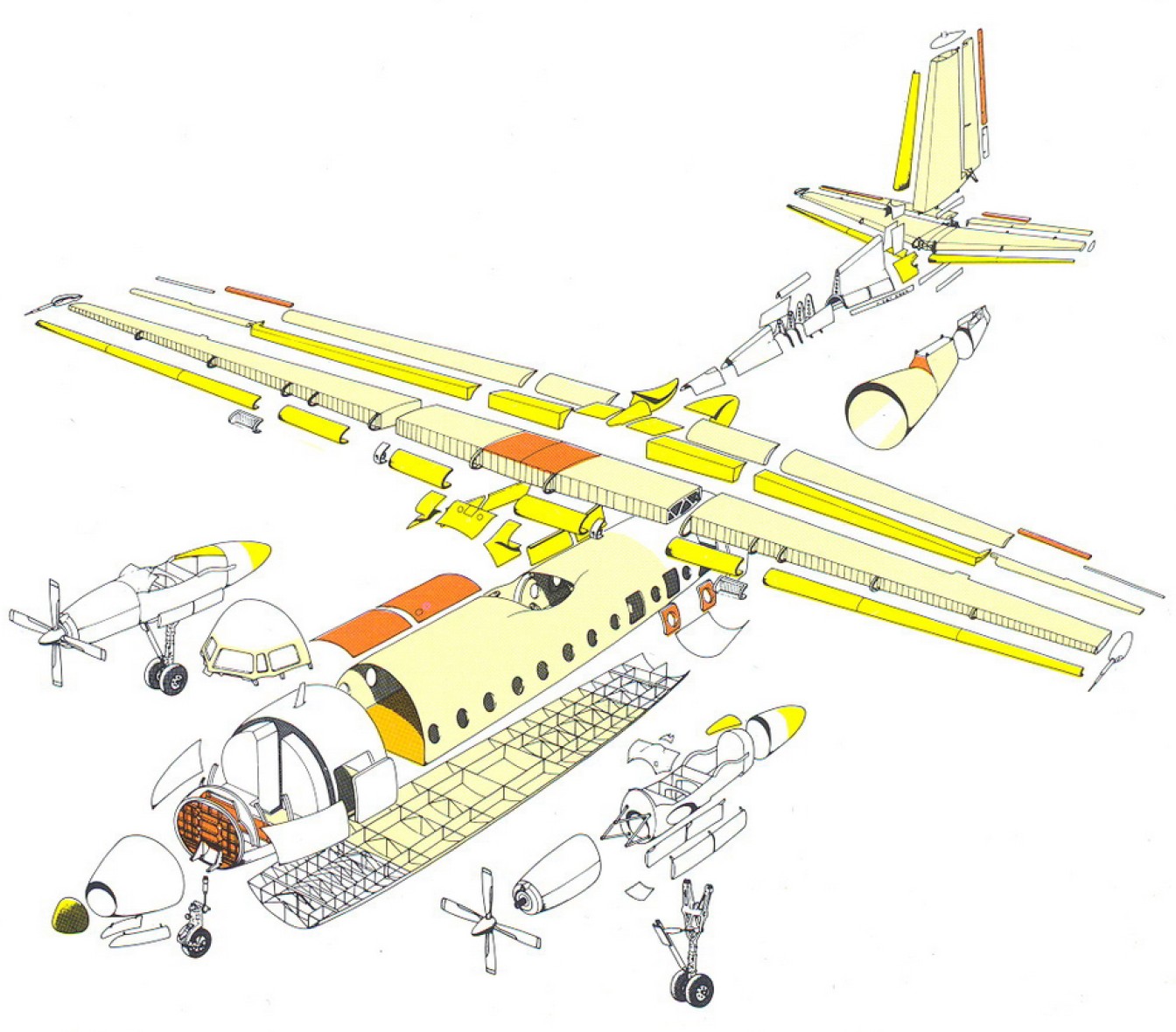
Fortunately, more orders started to come in. The hundredth F-27 was delivered to Philippine Airlines in September 1962, and by 1965, over 500 aircraft had been sold by Fokker and Fairchild. Additionally, Fokker had established an extensive service network to support the operational F-27 fleet.
It became clear in 1965 that there was a need in the American market for a slightly larger variant with extra seats. Fairchild extended its version by 198 cm for the wing so that the cabin could accommodate 56 passengers. This version became known as the Fairchild Hiller FH-227 and had Dart Mk-532-7 engines with a 3.50 meter diameter propeller. Aircraft were sold to Mohawk, Piedmont, and Ozark, among others.
Fokker also decided to extend the F-27 fuselage, 90 cm in front of the wing the wing and 60 cm behind the wing. This version became the F-27 mk.500, which was certified by the American FAA in May 1970.
There were still various variations of the F-27 in terms of cabins, engines, and other factors. The aircraft had truly become a workhorse for airlines and air forces. Modifications were carried out by Fokker or Fairchild, as well as other aviation companies. For example, conversions were even made to firefighting aircraft by the Canadian company ConAir. The KLu also modified an aircraft ("C-8") with a long F-104 Starfighter nose for navigation training. This aircraft was nicknamed "Flipper." Fairchild also made quite a few modifications to their F-27 and FH-227 aircraft. (For a summary of the variants, see above.)
In the mid-1970s, interest emerged in the military sector for patrol planes to be used over coastal waters and the like. English company Hawker was active in this market, as was Lockheed with its P-3 Orion due to the replacement of various Lockheed Neptunes around the world. Fokker believed it could offer a cheaper alternative with a maritime version of the F-27. The F-27M was developed, equipped with a search radar and various other equipment. It was also fitted with the stronger Dart engine with 2320 horsepower. In 1976, the F-27M, named Maritime, was ready. The Dutch State Secretary commissioned a study in 1978 to determine if the Maritime would be suitable for deployment from the Netherlands Antilles at lower costs. The result was positive and in June 1980, two planes were ordered for unarmed maritime operations in the Antilles, which were flown by the Royal Netherlands Air Force with Royal Netherlands Navy crews. It turned out that there was indeed considerable interest elsewhere, and Fokker also supplied Maritimes to Spain (3), Angola (1), Philippines (3), and Thailand (3).
Ultimately, the Fokker F-27 Friendship was a great success. It established Fokker's name after World War II. Eventually, 580 F-27 planes were built by Fokker from 1955 to June 1986, with serial number 10692, F-592 being the last. Fairchild ultimately built 128 F-27 and 78 FH-227 planes.
The Fokker 50 subsequently made its debut which had a similar configuration. Unfortunately, this type was not as successful. Its biggest competitor was the still-flying F-27! As of summer 2009, about 82 Fokker F-27 planes (civilian) were still in service.
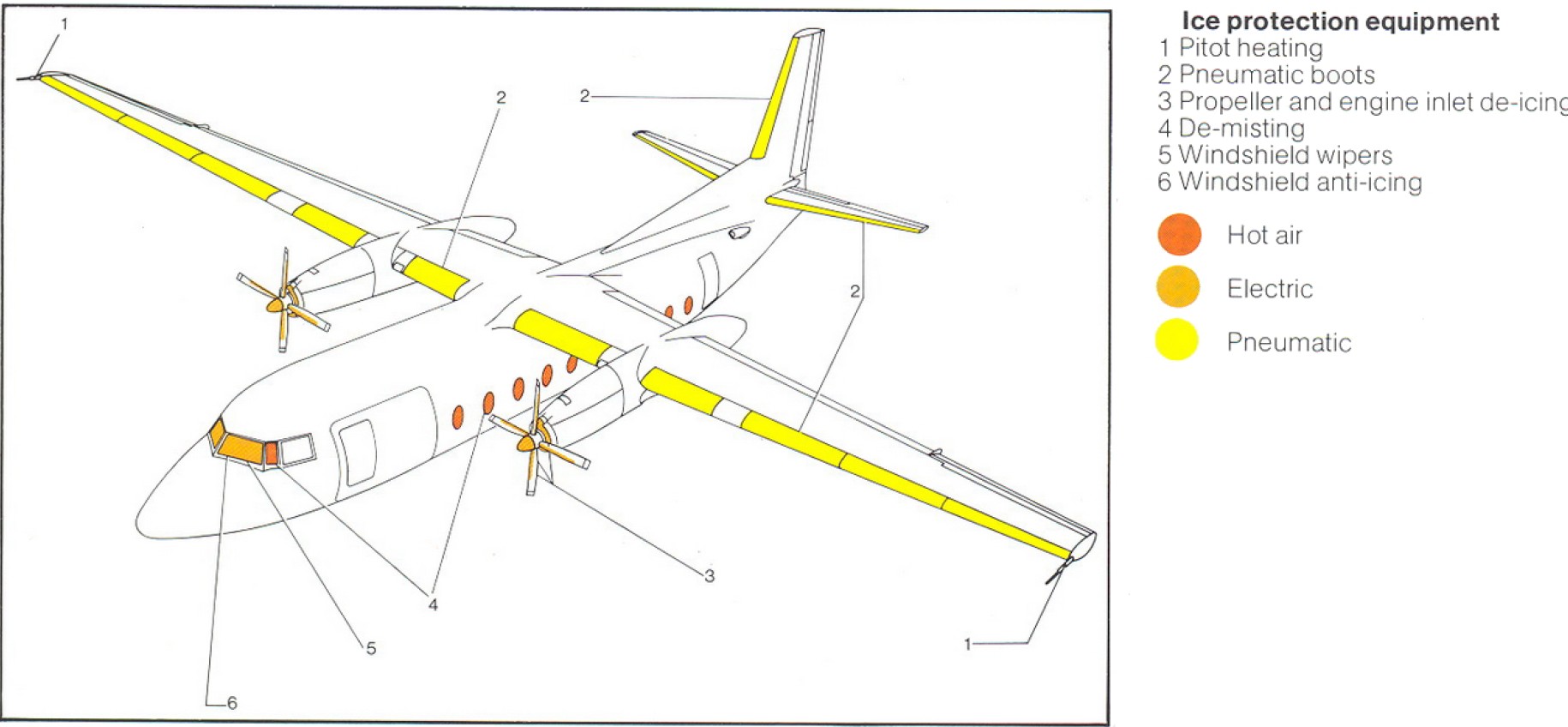
About the prototypes:
The prototype flew on November 24, 1955, and it was equipped with turboprops which was a new type of engine and glued structural joints. Fokker anticipated a large market because many war-era Douglas DC-3 aircraft needed to be replaced.
The F-27 prototype had a short cabin for 28 passengers, but the latere manufactured mk.100 had a 80 cm longer cabin for up to 32 passengers. The production type mk.100 was fitted with Rolls Royce Dart 511 engines. It first flew in March 1958, but the first airline, Air Lingus, received the aircraft in December 1958.
The mk.500 flew in November 1967, and the mk.600 flew in November 1968. The F-27 became the best-selling aircraft in its class, and there were various variants. Fairchild USA built the F-27 under license as the FH-227, with 205 aircraft built there.
There were also military variants of the F-27 with various equipment and for paratrooper transport with a different cabin interior. This was known as the "Troopship."
Overview of Fokker versions: F-27 prototypes:
"F-1" (construction number 10101): short fuselage length of 22.30 m and with a cabin for 28 passengers; Dart 6 Mk-507 engines and 3.65 m (12 feet) diameter props. Registration PH-NIV with a blue-white scheme. The aircraft was found to be tail-heavy, so the fuselage was lengthened. It also had double slotted flaps, which were not very effective. A modification was made with further flap deflection coupled to the stabilizer setting. However, they remained ineffective and were replaced by single flaps in the F-27 production versions. It flew from March 1956 to 1958, then with a Dart Mk-511 and from 1958 to June 1961 with the Dart Mk-528 engine. After June 8, 1961, it was decommissioned, and transported to the technical university TH Delft.
The "F-2" (c/n 10103) and the "F-4" (c/n 10104) were test objects for strength testing in the Fokker factory halls.
"F-3" (c/n 10102): the second flying prototype PH-NVF flew on January 29, 1957, with Rolls Royce Dart 6 Mk-511 engines and a 3.65 meter (12 feet) diameter propeller. The fuselage was already 90 cm longer than the "F-1." It had a red-white scheme and was also used for ice control tests, pressure cabin tests, and demonstrations. Later, a longer radar nose was also installed, and tests were conducted with fuel tanks under the wing. There were some accidents during testing where the aircraft had to land on its belly due to landing gear malfunctions. These emergency landings went well, proving that a high-wing configuration did have its advantages. It was leased to the German LTU after being repaired and fitted with a new structural skin. In early 1962, it was leased to Luxair but then sold to LTU.
Fairchild USA also made two prototypes: the N1027 and N2027. The N1027 flew on April 15, 1958, under the command of pilot Henson. The FAA certificate of airworthiness was granted in July 1958.

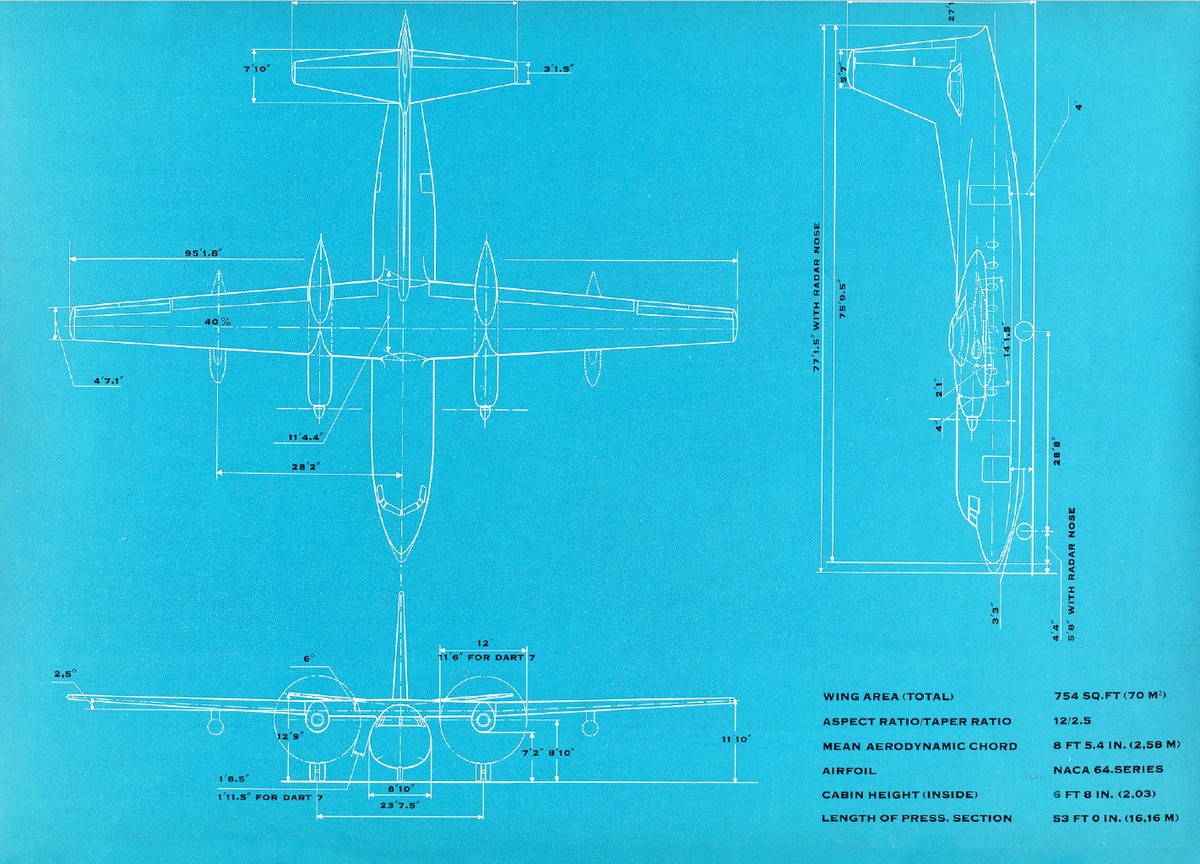
Fokker F-27 mk.100:
Cabin for 32 passengers which was thus 80 cm longer than the prototype. This cabin became the standard from then on. Fitted with Dart R.Da.5 mk.511 engines with 1600 hp and the only version with round-tipped propellers.
The first production type mk.100 flew in March 1958.
One aircraft was converted to the mk.100M marine version.
Originally, no radar in the short nose.
A total of 85 were built.
-----------
F-27 mk.200:
First flight on September 20, 1959.
Basic passenger version with Rolls Royce Dart mk.528-7R engines with 1900 hp. Introduction of straight-tipped propellers with a diameter of 3.65 m (12 feet, also on subsequent versions). Otherwise, it looks very similar to the mk.100, but the range was slightly smaller. Later, the maximum takeoff weight was increased slightly.
A total of 115 were built.
The mk.200M was a marine version (15 built).
------------------
F-27 mk.300 combiplane:
Cargo version of the mk.100 with a large cargo door (178 x 233 cm) on the left side of the fuselage and a reinforced floor.
Also, a movable cargo bulkhead in the cabin for use as a combiplane. (3 built; 2 for KLM, 1 for LTU)
F-27 mk.300M:
The cargo version is a slightly modified mk.300 with wide sliding doors at the rear of the fuselage measuring 162 x 117 cm for paradropping. It also had a large door at the front that hinges upward. The floor was also reinforced. It could be fitted with canvas seats for military transport, among other things.
Some 9 were built as mk.300M Troopship and delivered to the Royal Dutch Air Force (KLu), starting October 1960. Equipped with a long nose with radar.
-------------
F-27 mk.400 combiplane:
Cargo version of the mk.200 with a large cargo door on the left side and Dart mk.528 engines.
First flight on October 6, 1961.
A total of 18 were built.
F-27 mk.400M Troopship:
Military version for 45 paratroopers, 6000 kg of cargo, or 24 stretchers with 8 nurses in canvas chairs. It had a large cargo door and an enlarged paradrop door at the rear of the fuselage, as in the 300M.
First flight on April 24, 1965.
A total of 79 were built.
---------------
F-27 mk.400 Maritime:
Maritime variant based on the mk.400 to be used for maritime patrol. Equipped with a Dart engine with 2320 hp. Various surveillance systems and Litton search radar fitted in a dome below the fuselage. Extra fuel tanks and searchlight. The first flight was on March 25, 1976, but the Maritime prototype was an extended mk.100 (c/n 10168). Production aircraft were obviously new manufactured and had an extra APU and strengthened landing gear.
High takeoff weight of 20,000 kg.
F-27 mk.400 Cargo version:
Version with cameras and equipment, flew in August 1973.
---------------
F-27 mk.500:
The only longer cabin variant of the F-27, based on the mk.400; it had a cabin that was 1.5 m longer (90 cm in front of the wing and 60 cm behind the wing). It got a extended main gear to rotate in take-off and so the tail ground distance was therefore slightly higher. The landing gear was also slightly modified. Dart Da.108 engines with 1900 hp?
First flight in August 1973.
A total of 124 were built.
F-27 mk.500M: Longer version of the mk.400M but now for 50 parachutists, 6600 kg of cargo, or 30 stretchers.
---------------
F-27 mk.600: Version of the mk.200 but with a large cargo door and a quickly convertible cargo interior for pallets. Also capable of carrying 44 passengers. First flight on November 28th, 1968. A total of 132 were built.
FR-27 mk.700: An mk.100 but with a stronger cargo floor. Only one mk.1000 aircraft was converted.
The Enforcer, KingBird, Sentinel, and MS were military variants that were not built.
Technical information for the Fokker F-27:
Wing: Surface area of 70 m2. (about 753 sq.ft).
NACA 64 sereis with 64-121 wing profile at the wing root and NACA 64-415 profile at the tip.
Dihedral of 2.30 degrees.
Incidence of 3.30 degrees.
Single slotted flaps.
Aileron with trim tabs; aileron surface area of 3.51 m2.
Pneumatic rubber de-icing.
Fuselage: Stressed construction with a kink in the cross-section of the fuselage.
Inside cabin height: 2,03 m
Tail: Pneumatic de-icing; stabilizer span of 9.75 m; surface area of 16 m2.
Undercarriage: Pneumatic retractable system and brake system; track width c/l of 7.20 m; wheelbase of 8.74 m (mk.500: 9.74 m).
Engines: Various variants of the Rolls Royce Dart turboprop jet engines depending on version.
Propeller: Dowty Rotol constant speed prop, type depends on version with variations in diameter.
Fuel capacity: usually about 5169 liters. 9about 1364 gallons)
F-27-mk.100 data (first production version):
Length: 23.56 m (77 feet)
Wingspan: 29.00 m (95 feet)
Wing surface area: 70 m2
Height: 8.50 m
2 x Rolls Royce Dart 514-7 engines of 1670 hp with round propeller tips.
Empty weight: 10247 kg
Max takeoff weight: 18350 kg
Cruise speed: 420 km/h at 6000 m altitude
Cabin for 40 passengers
Single slotted flaps standard now.
(usually no radar in the nose)
F-27-mk.200 data:
Length: 23.56 m
Wingspan: 29.00 m
Wing surface area: 70 m2
Height: 8.50 m
2 x Rolls Royce Dart 528 engines of 2280 hp with propeller 3.65 m (12 feet) diameter
Empty weight: 11159 kg
Max takeoff weight: 20412 kg
Max speed: 480 km/h at 6000 m altitude
Cruise speed: 430 km/h at 6000 m altitude
Ceiling: 9000 m
Flight range of about 1930 km
Takeoff distance is around 710 m at 18000 kg weight at sea level
Landing distance is around 580 m at 17000 kg weight at sea level
No armament and normally 3 crew members in the cockpit;
Cabin for 44 passengers
F-27-mk.500 data:
Length: 25.06 m (longer fuselage)
Wingspan: 29.00 m
Wing surface area: 70 m2
Height: 8.71 m (tail raised slightly due to longer fuselage)
2 x Rolls Royce Dart 536-7 engines of 2140 hp on the propeller
Empty weight: 12303 kg
Max takeoff weight: 20411 kg
Cruise speed: 421 km/h at 6000 m altitude
Ceiling: 9000 m
Flight range of about 1315 km
Cabin for 52 passengers
The Fairchild F-27 and Fairchild Hiller FH-227 were versions of the Fokker F27 and manufactured under license by Fairchild Hiller in the United States. The Fairchild F-27 was similar to the standard Fokker F27, while the FH-227 was an independently developed, stretched version.
Fairchild F-27s differed having basic seating for 40 (-100), heavier external skinning, a lengthened nose capable of housing weather radar, and additional fuel capacity. The longer nose for the weather radar was a Fairchild development (and later also offered by the Fokker company and thus called the "Fairchild nose"). Adapted technical drawings and tools were used during manufacturing. The type had a US F.A.A. flight certificate.
Fairchilds also incorporated a passenger airstair door in the rear of the aircraft in stead of a cargo door. Though costing weight, it enabled quick unloading with no need for separate stairs on the ground.
Fuselages could have a different number of passenger windows. Later the large airconditioning cooling scoop was removed and faired slots introduced. The Fairchild F-27 had the Dart 6 engine and F-27 (fuselage -100). The F-27A (fuselage -200) had the Dart 7, F-27B ( fuselage -300) Dart 6 and large freight door. The versions F-27F, F-27J and F-27M were derivatives of the F-27A but with higher take-off weights and uprated engine ratings.
The F-27B Combi had a mix of passenger/freight and was operated in Alaska by Northern Consolidated Airlines and Wien Air Alaska.
Fairchild Hiller independently developed after a decline in airline orders a consirably stretched version, the FH-227; (it appeared almost two years earlier than the longer Fokker's F27-500).
The FH-227 featured a FULL 1.83 m stretch forward of the wing only with now a passenger capacity of 56 and a cargo area between the cockpit and the passenger cabin. It first flew beginning 1966.
Fairchild versions:
F-27A: Based on the mk.200 (1958)
F-27B: Fitted with Dart 6 engine, with a large cargo door and resembling the mk.300
F-27F: Business version with Dart Mk-529-7E engines with 2190 horsepower. Air intake now on top of the fuselage for the tail. Propeller diameter probably 11 ft. 6" (3.50 m)
F-27J: For Allegheny Airlines: fitted with Dart Mk-532-7.
F-27M (not to be confused with the Maritime): Dart Mk-536-7 with a larger propeller with a diameter of 3.85 m. This provided better performance at altitude for the airline L.A.B. that flew in Bolivia on high-altitude fields.
FH-227: Fuselage for wing 2 meters longer and based on the F-27J. Dart 7/532 engine.
FH-227B and C: Got larger propellers
FH-227D: Stronger Dart Mk-532-7L engines.
FH-227E: Same as -D, "Cargonaut" was a version with a cargo door and longer fuselage.
Fairchild FH-227 Technical Data:
Length: 25.50 m; the longest fuselage of all F-27 versions, full stretch in front of wing.
Wingspan: 29.00 m
Wing area: 70 m2
Height: 8.41 m
2 x Rolls Royce Dart engines (varies from 2000 to 2250 hp)
Cruising speed: 430 km/h at 6000 m altitude
Range approximately 1000 km
Cabin for 54 passengers.
REAL F-27 AIRCRAFT PHOTOS
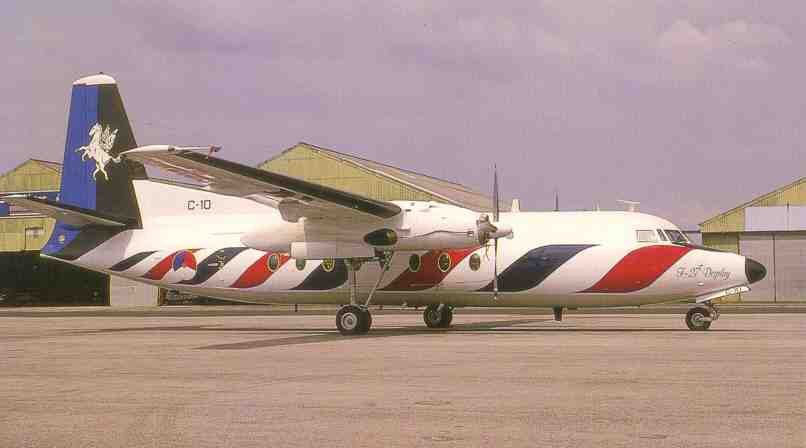
Photos
of the "real thing"
, kindly provided by Bas Damen
Details of a Fokker F-27M-300
aircraft are presented here, with a demo aircraft being depicted. Coded
C-10 of the Royal Netherlands Air Force in 1992.
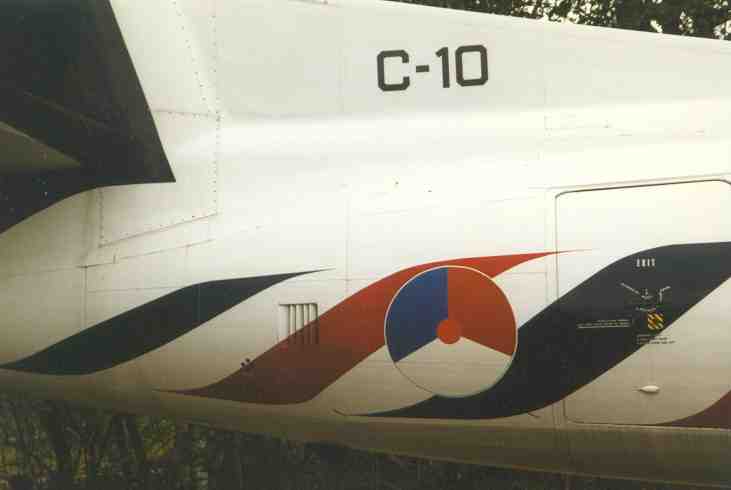
The tail fin at the aft fuselage is
quite large, with also the fuselage having a lot of curved red/blue striping.
Note the special intake on the aft section which can differ from aircraft
to aircraft.
These stripes are also below the wing with the engine exhaust and flap and nacelle with 4-bladed propeller having a black/white spiral.

.

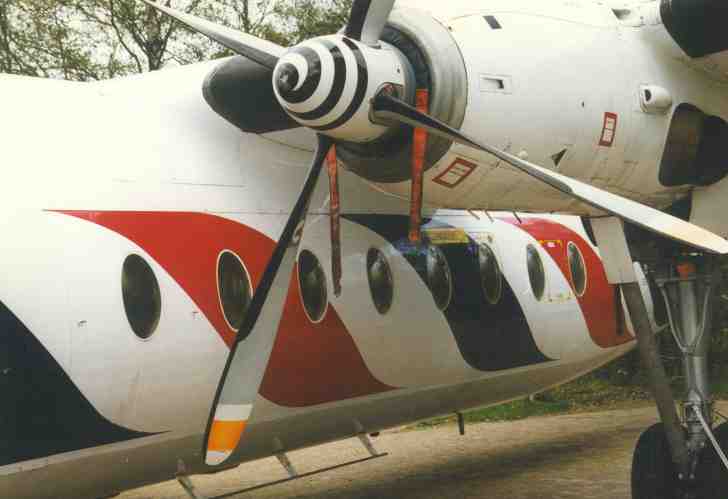
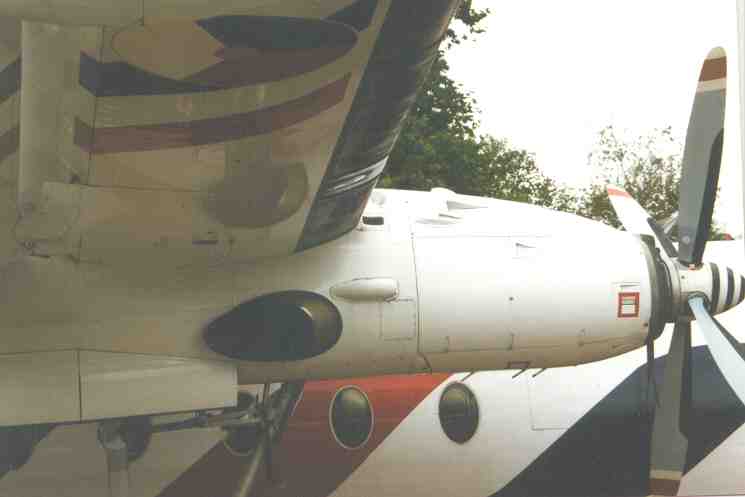
This F-27M-300 demo plane has a white horse/ stallion on it, from the squadron badge.
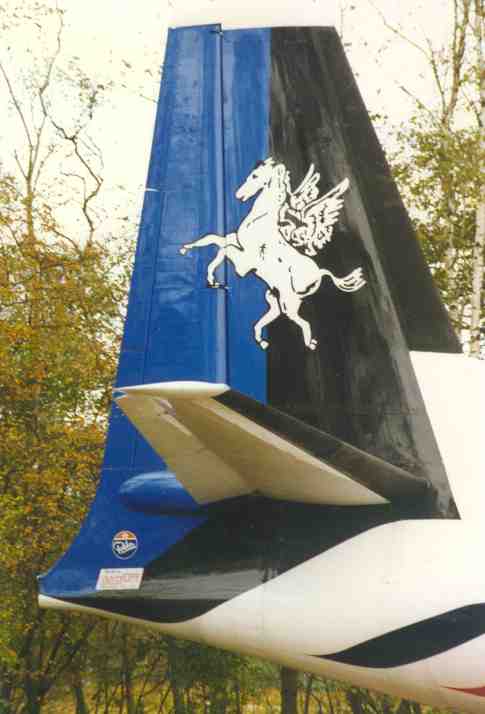
The nose undercarriage of the F-27
has a single wheel.
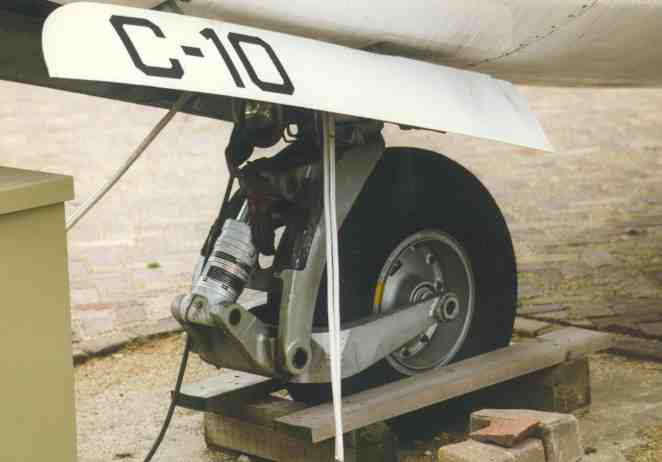
Normally, the RNethAF F-27's were
having a camouflage scheme or a normal "civilized" white scheme.
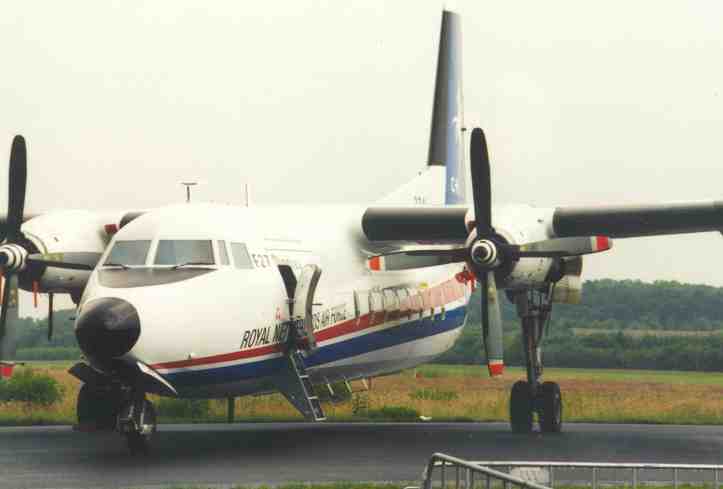
Propellers can have a round or later retrofitted square
tip, both variants are found on F-27 aircraft.
The re-issued Airfix F-27 1/72 scale kit has decals for this plane and the parts for the radar nose and square tipped propellers. The cheatlines in the decals are correct with appropriately sized windows.
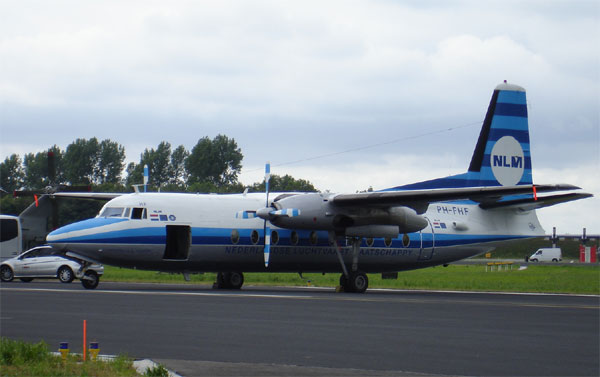
As per summer 2009, 82 Fokker F-27 Friendships were still operational and 168 Fokker 50 aircraft.
The Fokker F-27 family was later the basis of the modernized Fokker 50 and Fokker 60 aircraft family.
Scale drawings Fokker F-27
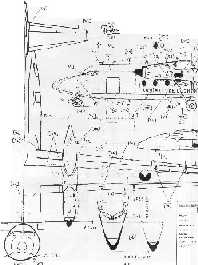
Part 1 [60 KB]
Part 2 [84 KB]
Print out the two parts
- Check out scale: wing span should be 29.00 m for all versions, so that's 40,3 cm in 1/72 scale
- Enlarge/reduce as needed to get the exact scale
(c) Copyright: Meindert de Vreeze
References
Books and magazines:
- (1) Modelbouw In Plastic MIP 4/1978 over F-27
- (2) Modelbouw In Plastic MIP 1/1979 over F-27
- (3) Modelbouw In Plastic MIP 4/1993 over F-27 Deel (1)
- (4) Fokker 50 (en F-27) for the eighties, Air International, Volume 26.nr 4 (april 1984)
- (5) Diversen: Onze Luchtmacht / Vliegende Hollanders/ Spiders...
- (6) 50 jaar Fokker Friendship, Joop Gerritsma, Publisher De Alk, The Netherlands, ISBN 90 6013 268 8
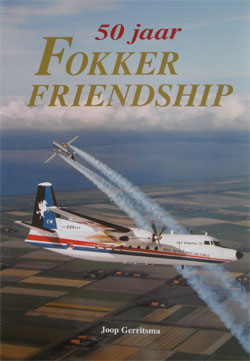
------------------
INTERNET:
- IPMS NEDERLAND F-27 walk around pages...
- IPMS Nederland F-27 info pages...
Back to F-27 model page...

(c) Copyright "designer"/ All rights reserved. Your comments are welcomed by webmaster
created this page: August 2005